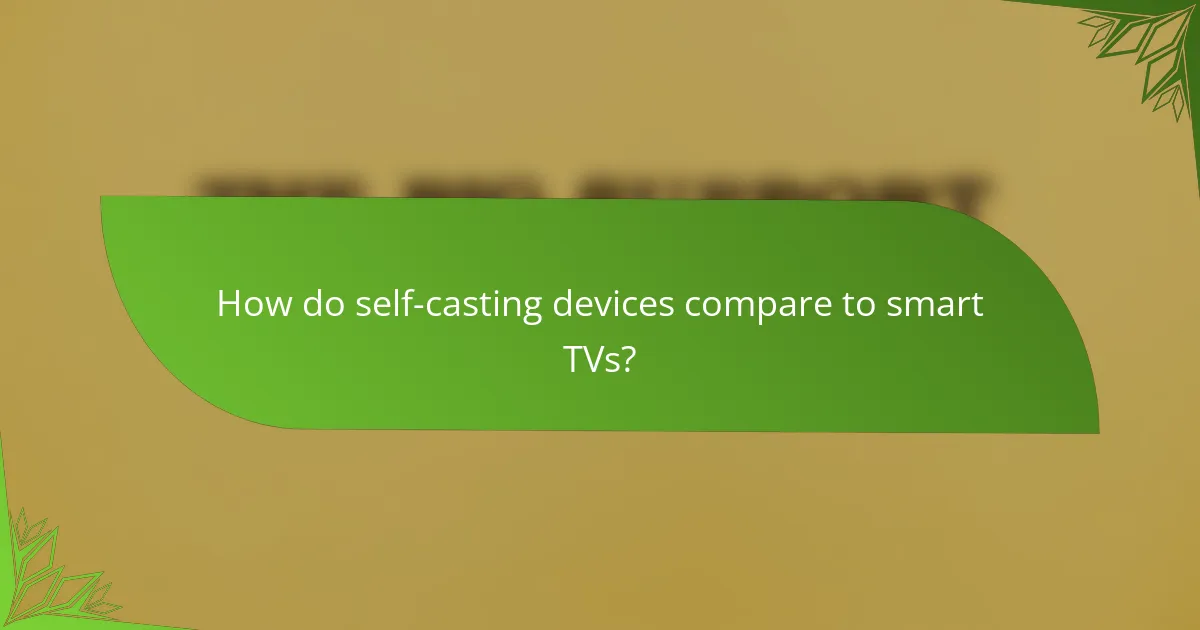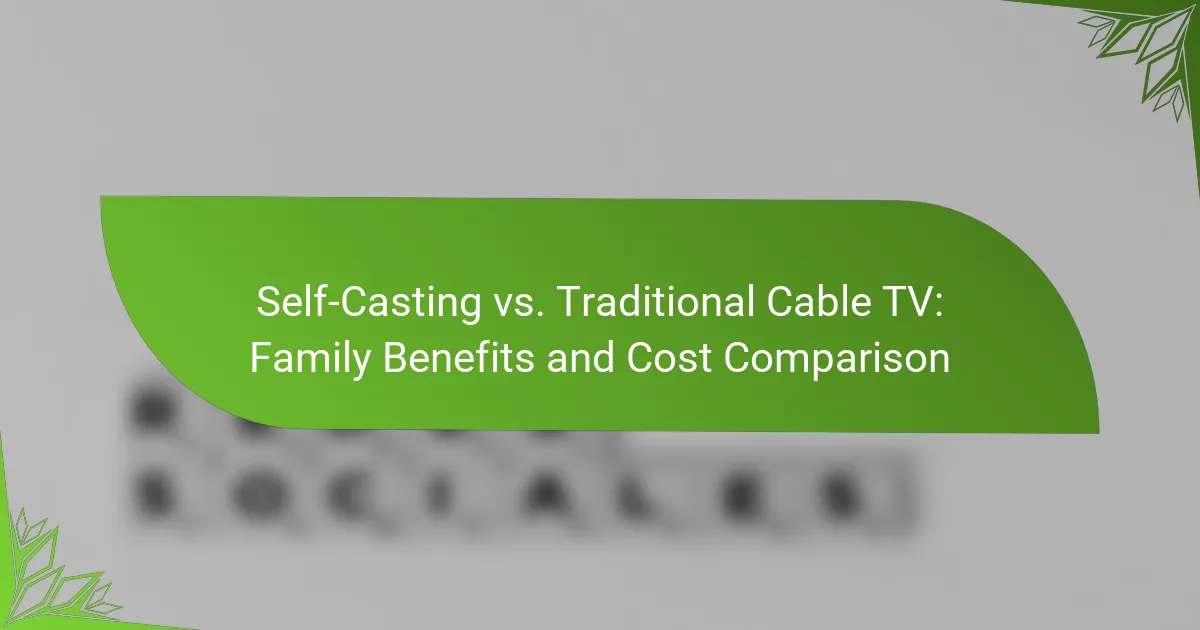When it comes to enhancing your home entertainment experience, choosing between self-casting devices and smart TVs is crucial. Self-casting devices offer affordability and versatility, allowing users to stream content from various devices without needing a smart TV. In contrast, smart TVs come equipped with built-in streaming capabilities and high-quality displays, providing a seamless viewing experience. Understanding the differences in functionality and user experience can help you make the right choice for your home.

What are the advantages of self-casting devices?
Self-casting devices offer several benefits, including affordability, versatility, and user-friendliness. They allow users to stream content from various devices to their TV without the need for a smart TV, making them an attractive option for many households.
Cost-effective streaming
Self-casting devices, such as Chromecast or Roku, are generally more affordable than smart TVs. Prices typically range from around $30 to $100, depending on features and capabilities. This lower cost makes it easier for consumers to upgrade their existing TVs without investing in a new one.
Moreover, self-casting devices often provide access to a wide range of streaming services, allowing users to save on subscription fees by choosing only the platforms they want. This flexibility can lead to significant savings over time.
Compatibility with multiple platforms
Self-casting devices are designed to work with various operating systems and platforms, including iOS, Android, Windows, and macOS. This broad compatibility means users can easily stream content from their smartphones, tablets, or computers to their TVs.
Additionally, many self-casting devices support popular streaming services like Netflix, Hulu, and YouTube, ensuring users have access to a diverse library of content. This versatility is a key advantage over smart TVs, which may have limited app availability based on their operating system.
Portability and ease of use
Self-casting devices are typically compact and lightweight, making them easy to transport and set up in different locations. Users can take them on trips or move them between rooms without hassle. This portability is particularly useful for those who travel frequently or want to use their devices in various settings.
In terms of usability, self-casting devices often feature straightforward setup processes and intuitive interfaces. Most users can connect them to their Wi-Fi networks and start streaming within minutes, making them accessible even for those who may not be tech-savvy.

What are the benefits of smart TVs?
Smart TVs offer a range of benefits, including built-in streaming capabilities, user-friendly interfaces, and high-quality display options. These features enhance the viewing experience by providing easy access to content and superior picture quality.
Integrated streaming services
Smart TVs come with integrated streaming services like Netflix, Hulu, and Amazon Prime Video, allowing users to watch their favorite shows and movies without needing additional devices. This built-in functionality simplifies the viewing experience by consolidating multiple services into one platform.
Many smart TVs support various streaming apps, often pre-installed, making it easy to start watching right out of the box. Users can typically download additional apps from their TV’s app store, expanding their content options significantly.
User-friendly interfaces
The user-friendly interfaces of smart TVs make navigation straightforward, even for those who are not tech-savvy. Most models feature intuitive menus and remote controls designed for easy access to apps and settings.
Voice control capabilities are increasingly common, allowing users to search for content or change settings using simple voice commands. This accessibility can enhance the overall viewing experience, especially for families or older adults.
High-quality display options
Smart TVs are available in various display technologies, including LED, OLED, and QLED, each offering different advantages in terms of brightness, color accuracy, and contrast. These high-quality display options ensure that viewers enjoy a vibrant and immersive experience.
When choosing a smart TV, consider the resolution as well; 4K models are now standard and provide significantly sharper images compared to lower resolutions. Additionally, many smart TVs support HDR (High Dynamic Range), which enhances color and contrast for a more lifelike picture.

How do self-casting devices compare to smart TVs?
Self-casting devices and smart TVs serve the same purpose of streaming content, but they differ significantly in functionality and user experience. Self-casting devices, like Chromecast or Roku, require an external device to stream content from a smartphone or tablet, while smart TVs have built-in capabilities to access streaming services directly.
Performance differences
Self-casting devices generally offer flexibility and can enhance the performance of any standard TV by providing access to various apps and services. However, smart TVs often have faster processing speeds and better integration with their operating systems, resulting in smoother navigation and quicker load times.
For instance, a high-end smart TV may have a response time in the low tens of milliseconds, while a self-casting device might introduce slight delays depending on the network connection. Users should consider their internet speed and the specific models when evaluating performance.
Feature comparisons
Smart TVs come equipped with a variety of built-in features, such as voice control, app stores, and screen mirroring capabilities, which can enhance the viewing experience. In contrast, self-casting devices primarily focus on streaming and may lack some advanced features found in smart TVs.
For example, many smart TVs support HDR and 4K content natively, while self-casting devices may require compatible TVs to fully utilize these features. Users should assess their content preferences and whether they need additional functionalities when choosing between the two options.
Price range analysis
The price of self-casting devices typically ranges from around $30 to $100, making them an affordable option for enhancing existing TVs. Smart TVs, on the other hand, can vary widely in price, starting from a few hundred dollars to several thousand, depending on size and specifications.
When budgeting, consider not only the initial purchase price but also potential long-term costs, such as subscriptions to streaming services. A self-casting device may be a cost-effective choice for those who already own a quality TV and want to access streaming without a significant investment.

What factors should you consider when choosing between self-casting and smart TVs?
When deciding between self-casting and smart TVs, consider your viewing habits, budget, and the space available for setup. Each option has distinct advantages and limitations that can influence your choice based on how you plan to use the technology.
Usage scenarios
Self-casting is ideal for users who frequently stream content from mobile devices or laptops, allowing for easy sharing of videos, photos, and presentations on a larger screen. Smart TVs, on the other hand, come with built-in apps and services, making them suitable for users who prefer a standalone device without needing additional gadgets.
If you often host gatherings or enjoy gaming, self-casting can enhance the experience by allowing multiple users to connect their devices. However, if you primarily watch streaming services like Netflix or Hulu, a smart TV may provide a more seamless experience with dedicated apps and remote controls.
Budget constraints
Your budget will significantly impact your choice between self-casting and smart TVs. Smart TVs can range from a few hundred to several thousand USD, depending on the brand, size, and features. In contrast, self-casting devices, such as Chromecast or Roku, are generally more affordable, often costing under 100 USD.
Consider not only the initial purchase price but also potential subscription fees for streaming services. If you opt for a smart TV, ensure it supports the platforms you intend to use to avoid additional costs later on.
Space and setup requirements
Space and setup are crucial factors when choosing between self-casting and smart TVs. Smart TVs require adequate wall or furniture space, and you may need to consider cable management and power outlets. Self-casting devices are typically compact and can be easily connected to existing TVs, making them a flexible option for smaller spaces.
Additionally, smart TVs may require a more complex setup process, including internet connectivity and software updates. Self-casting devices usually offer a straightforward plug-and-play experience, allowing you to start streaming quickly without extensive configuration.

What are the top self-casting devices available in 2023?
In 2023, the leading self-casting devices include Google Chromecast and Amazon Fire TV Stick, both offering unique features for streaming content directly to your TV. These devices allow users to easily cast videos, music, and other media from smartphones or tablets, enhancing the home entertainment experience.
Google Chromecast
Google Chromecast is a versatile streaming device that connects to your TV’s HDMI port and allows you to cast content from various apps on your mobile device. It supports a wide range of streaming services, including Netflix, YouTube, and Spotify, making it a popular choice for many users.
One of the key advantages of Chromecast is its ease of use; simply connect it to your Wi-Fi network, and you can start casting within minutes. It also supports 4K streaming, which is ideal for those with compatible TVs, providing high-quality visuals for your favorite shows and movies.
Amazon Fire TV Stick
The Amazon Fire TV Stick is another popular self-casting device that plugs into your TV’s HDMI port and offers access to a vast library of streaming services. It comes with a remote control, allowing for easy navigation through apps and content without needing a smartphone.
This device supports Alexa voice commands, enabling hands-free control of your TV and smart home devices. The Fire TV Stick also offers various models, including options for 4K streaming, which can enhance your viewing experience significantly.










